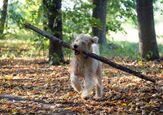Turning His Back On You? Your Dog May Have a Good Reason.

It's not you. It's him. And his reasons may surprise you.
My Schnoodle Ruby is relentless when positioning herself smack dab in front of my legs, yet facing away as if she’s ignoring my efforts to interact with or simply move past her. When seated, I’ve always assumed that this was her way of showing me she was “available” for a back rub or patting session should I be so inclined. When standing, I was certain that she was trying to guide me toward food or the treat drawer. Apparently, I have it all wrong. Or at least, partially wrong.
You see, there are several reasons a dog will behave this way with someone he knows and trusts. And more often than not, it has nothing to do with him waiting to receive a snuggle from behind.
Per the American Kennel Club (AKC)- who we all know is the absolute gurus of anything “dog” - it may actually be your pet’s way of showing you that he wants to be left alone. This could be down to him feeling tired or unwell and therefore, disinterested in interacting with you. Be respectful and allow him some down time. But be sure to monitor for signs that suggest he's not simply tired but is in any sort of discomfort or ailing.
And yes, there may be other reasons. If you’re in unfamiliar surroundings or he’s been introduced to new faces (both human and animal), this can also be his way of indicating fear or anxiety. The thought is that by turning away, your dog presents himself as less threatening and thereby can avoid potential conflict.
Of course, when you’re at a dog park or he’s interacting with other dogs for the first time, you’ll notice the sniffing of rear-ends that inevitably takes place. Each poochie’s behind carries a scent unique to that dog and it helps all parties establish a pecking order once the sniff is complete. In this instance, the dominant dog will typically take the first whiff. So, when your pet is sitting with his back/butt to you, just know that he’s telling you he sees you as the alpha and this is his way of showing submission.
Of course, context is everything. If your pet has been showing signs of anxiety or fatigue, turning his back to you will help send the signal that allows you to respond accordingly - and provide him some space.
Similarly, if you notice him acting this way around other animals, be sure to monitor the interaction because your pooch is telling you (and the other animal) that he’s feeling the need to be submissive. And that could mean he’s uncomfortable and becoming stressed around this particular dog. So, it may be time to exit the situation.
Lastly, we circle back to my initial theory on why wee Ruby is turning her back on me. If you have a positive relationship with your pet, this could also be their way of showing you that they trust you, feel at ease and are comfortable in your company.
So, as with most dog behaviors, observe, assess, and react appropriately. And in the end that just may mean a cuddle and a backrub.

Sharing space with three seriously judgy Schnoodles and 2 felines who prefers to be left alone. #LivingMyBestLife
More by Mary Simpson






















